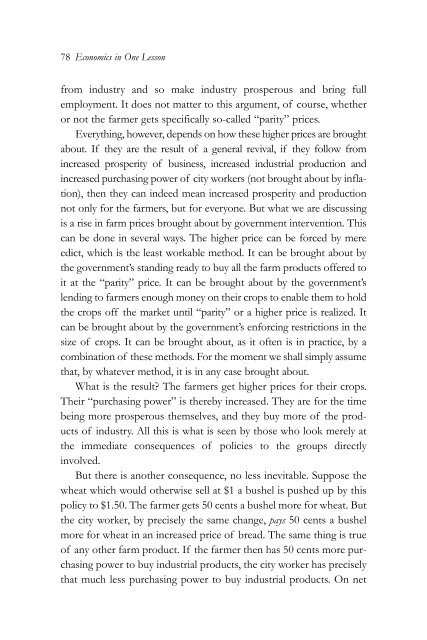1gDdM7w
1gDdM7w
1gDdM7w
- No tags were found...
Create successful ePaper yourself
Turn your PDF publications into a flip-book with our unique Google optimized e-Paper software.
78 Economics in One Lessonfrom industry and so make industry prosperous and bring fullemployment. It does not matter to this argument, of course, whetheror not the farmer gets specifically so-called “parity” prices.Everything, however, depends on how these higher prices are broughtabout. If they are the result of a general revival, if they follow fromincreased prosperity of business, increased industrial production andincreased purchasing power of city workers (not brought about by inflation),then they can indeed mean increased prosperity and productionnot only for the farmers, but for everyone. But what we are discussingis a rise in farm prices brought about by government intervention. Thiscan be done in several ways. The higher price can be forced by mereedict, which is the least workable method. It can be brought about bythe government’s standing ready to buy all the farm products offered toit at the “parity” price. It can be brought about by the government’slending to farmers enough money on their crops to enable them to holdthe crops off the market until “parity” or a higher price is realized. Itcan be brought about by the government’s enforcing restrictions in thesize of crops. It can be brought about, as it often is in practice, by acombination of these methods. For the moment we shall simply assumethat, by whatever method, it is in any case brought about.What is the result? The farmers get higher prices for their crops.Their “purchasing power” is thereby increased. They are for the timebeing more prosperous themselves, and they buy more of the productsof industry. All this is what is seen by those who look merely atthe immediate consequences of policies to the groups directlyinvolved.But there is another consequence, no less inevitable. Suppose thewheat which would otherwise sell at $1 a bushel is pushed up by thispolicy to $1.50. The farmer gets 50 cents a bushel more for wheat. Butthe city worker, by precisely the same change, pays 50 cents a bushelmore for wheat in an increased price of bread. The same thing is trueof any other farm product. If the farmer then has 50 cents more purchasingpower to buy industrial products, the city worker has preciselythat much less purchasing power to buy industrial products. On net


